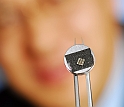News Release 07-036
Minuscule Generators Convert Motion Into Nanoscale Electricity Source
Energy from tiny movements, ultrasound waves and even bloodflow can charge the devices

Georgia Tech researcher Zhong Lin Wang holds a prototype nanogenerator.
April 5, 2007
This material is available primarily for archival purposes. Telephone numbers or other contact information may be out of date; please see current contact information at media contacts.
In a breakthrough that could free nanomachines from the bulk of batteries, researchers have developed a novel nanogenerator--an array of tiny filaments that converts the smallest motions into electrical current.
The nanowires are crafted from zinc oxide, a safe material that would allow the generator to be used in biomedical applications, and may eventually power nanomotors, tiny sensors, and if in large enough arrays, macroscale devices.
Georgia Institute of Technology engineer Zhong Lin Wang and his colleagues announce the development in the Apr. 6 issue of Science.
The researchers developed the generators with the support of the National Science Foundation, the Defense Advanced Research Projects Agency and the Emory-Georgia Tech Nanotechnology Center for Personalized and Predictive Oncology.
Additional information is available in the Georgia Tech press release at http://www.gatech.edu/news-room/release.php?id=1326
The research was supported by the NSF Metals Program in the Division of Materials Research through award DMR 9733160.
-NSF-
-
A prototype nanogenerator was fabricated using an array of zinc oxide nanowires.
Credit and Larger Version
Media Contacts
Joshua A. Chamot, NSF, (703) 292-7730, email: jchamot@nsf.gov
John Toon, Georgia Institute of Technology, (404) 894-6986, email: john.toon@innovate.gatech.edu
Program Contacts
Harsh Deep Chopra, NSF, (703) 292-4543, email: hchopra@nsf.gov
Principal Investigators
Zhong Lin Wang, Georgia Institute of Technology, (404) 894-8008, email: zhong.wang@mse.gatech.edu
The U.S. National Science Foundation propels the nation forward by advancing fundamental research in all fields of science and engineering. NSF supports research and people by providing facilities, instruments and funding to support their ingenuity and sustain the U.S. as a global leader in research and innovation. With a fiscal year 2023 budget of $9.5 billion, NSF funds reach all 50 states through grants to nearly 2,000 colleges, universities and institutions. Each year, NSF receives more than 40,000 competitive proposals and makes about 11,000 new awards. Those awards include support for cooperative research with industry, Arctic and Antarctic research and operations, and U.S. participation in international scientific efforts.
Connect with us online
NSF website: nsf.gov
NSF News: nsf.gov/news
For News Media: nsf.gov/news/newsroom
Statistics: nsf.gov/statistics/
Awards database: nsf.gov/awardsearch/
Follow us on social
Twitter: twitter.com/NSF
Facebook: facebook.com/US.NSF
Instagram: instagram.com/nsfgov



